![]()
![]()
![]()
Use LEFT and RIGHT arrow keys to navigate between flashcards;
Use UP and DOWN arrow keys to flip the card;
H to show hint;
A reads text to speech;
30 Cards in this Set
- Front
- Back
|
Archaic Period (600-480 BCE) Kritios Boy (480 BCE) Classical Period (500-323 BCE) Hellenistic Period (323-30 BCE) |
Greek Periods |
|
|
Alphabet more developed, writing and literacy, dramatic changes in greek culture thanks to influence through trade Greece will begin to transform more dramatically, but borrow heavily from other cultures military also transformative effect, redefines status of men black and red figure technique for pottery painting stiff (egyptian influence) sculpture simple temples, doric columns |
Archaic Period |
|
|
start with slip on surface to set silhouette
oxidizing in kiln reducin reoxidizing oxygen turns it red, except for the slip which stayed black |
Black figure technique |
|
|
same firing process except used slip to created negative space instead of using the stylus to engrave, artists painted on red clay with slip |
Red figure technique |
|
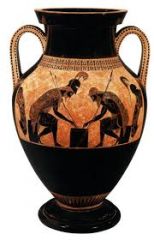
|
Amphora showing achilles and ajax playing a game by exekias 540 BCE greece Achilles victor of game- he gets kills- ajax takes his own life in despair, humanity of heroes dice game |
|
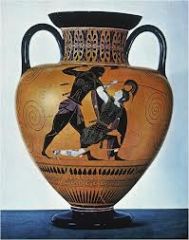
|
Achilles killing the amazon queen penthesilea black figured amphora, sig by exekias 540 BCE athens fell in love with her right when he killed her |
|

|
Niobides Krater (anonymous vase painter called niobid painter 460-450 BCE) transition between archaic and classical niobid brags about fertility to leto, lets children artemis and apollo kill all of his children Herakles (in flesh or stone?) warriors and athena, specific to marathon? first time in greek vase painting figures are situated at different levels, |
|
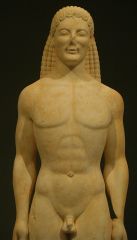
|
Kuros (kouroi) often painted, heroic nude, usually a commemorate function (grave markers, in sanctuaries, replaces vases) possibly reference to virile, athletic, warrior ancestors many have archaic smile eyes inlaid with stone and glass |
|
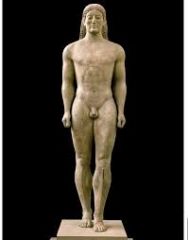
|
Anavysos Kouros 530 BCE marble and paint athens unatural stiffness the shoulders are level the hips are level both fists are level |
|

|
Peplos Kore acropolis athens 530 BCE BCE, 4 ft peplos= long, belted garment painted hand extends (breaks archaic mold) probably a goddess maybe athena? |
|

|
Kritios Boy 480 BCE ushers in the early classical age changes everything controposito- shifting of weight from one leg to the other, natural relaxed body pose |
|
|
Math Harmony and balance experiment with the idea that perfection achieved through distortion types of columns doric column- no base, 16 to 20 flutes, and the shaft tapers upward 2. ionic column- more decorative and slender than the doric column, consists of a scroll on top of the column, circular base, 24 flutes 3. corinthian columns- more decoration than any of the other columns usually foliage or flora |
Classical Architecture |
|
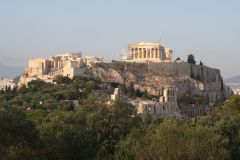
|
The acropolis (city on a hill) Marble, pericles athens 450 BCE rebuilt under pericles, after devastation caused by persians, religious and ceremonial center dedicated primarily to athena, but also a testament to strength of greek mortals all sacred spaces built here the pathenon is a symbol of- democracy, rise after defeat, classic ideals, humanism over barbarism, logic over emotion, power |
|
|
k |
Plan of the Acropolis 1. Parthenon2. old temple of athena3. erechtheion6. temple of athena nike15 and 18 are theaters cult statues to athena with permission from priests most athenian citizens had access to inner sanctuaries, but oat worship from outside |
|
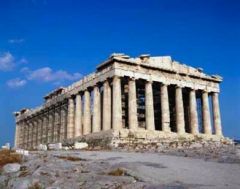
|
Iktinos and Kallikrates Partheon 447 BCE viewed from exterior east and west entrances inner rooms known as the cella no right angles, curves compensate for optical distortion caused by light shadows and distance entasis, swelling doric and interior ionic |
|
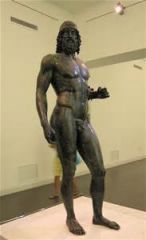
|
Riace Bronzes 450 BCE |
|
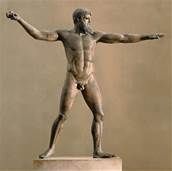
|
Zeus or poseiden 450 BCE bronze bronze looks more life like able to show more movement |
|
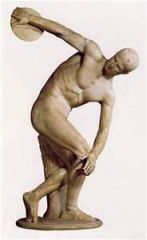
|
Diskobolos (discus thrower) by myron 450 bce roman copy of greek bronze |
|
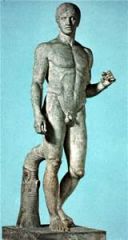
|
Doryphoros (spear bearer) by polykleitos 450 BCE roman copy of greek bronze shows underlying harmonic proportions, ratios found, everything in nature, beauty, could be understood as numeric ratios |
|

|
Athena parthenos, by Phidias Interior for cult statue and treasury nike is on the right of her she has weapon, shield, and serpent serpent story |
|
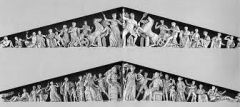
|
Pediment on parthenon pediment- triangular section found above the horizontal structure typically supported by columns tympanum- the actual decorated triangle |
|
|
lapith versus centaurs, amazon v greeks, trojans v greeks, civilized vs uncivilized |
Metopes |
|

|
Portion of Frieze of ergastines with athenas peplos 430s marble phidias? penathenaic procession everyone is going to celebrate athenas birthday making her a peplos seen from below so the artists carved the higher part deeper and the lower part in lower relief first time we see people elevating themselves in a sacred space, want to see procession and sacrifice depicted in a sacred space, connection with gods |
|
|
greek religious temple for 1000 years alexander used parthenono as symbol of conquest 5th c turned into christian church 15th ottomans made it a mosque and built a minaret 17th c turks used as an arsenal venetians bombed it during wars turks kept control 19th c turks sold right to remove and borrow sculptures for making molds and drawing to the british elgin kept them then sells to parliament 183os greece becomes independent and wants them back still 5th c BCE pericles pathenon projected athenian imperialism superior, slavery and imperialism |
history of the parthenon |
|
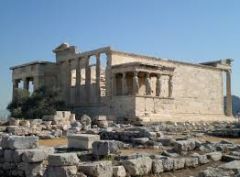
|
The Erechtheion 420 BCE marble in the acropolis Cant enter from all sides there is a wall some columns are women ionic columns no symmetry landscape sacred restrictions different levels, uneven terrain built to honor athenas legendary son built over poseidons trident marks and athenas olive tree contained athenian statue, statue gifted by the gods she had virgin priestesses who would continuously feed serpents honey cake ionic columns and caryatids- sculpted female figure serving as an architectural support |
|
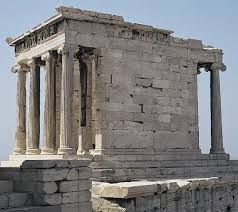
|
Kallikrates- temple of athena nike 420s BCE slender sleek design ionic |
|
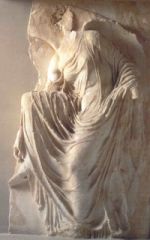
|
Nike adjusting her sandal 410 BCE 3'6" temple of athena nike acropolis athens high relief most famous for drapery (wet drapery) off balance, relaxed but stage greeks becoming more comfortable with female form artist captured tiny moment humanness of the gods |
|
|
lz |
Agora 5th century BCE public space for government, religion, public discourse, athenian democracy during the classic agree markets law courts different public buildings |
|
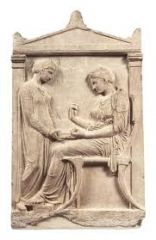
|
Grave stele of Hegeso attributed by Kallimachos 410 BCE athens marble and paint from the dipylon cemetery athens wealthy family private sculpture looking at jewelry father being honored communicating to the public maid: less drapery |
|
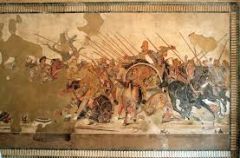
|
Alexander Mosaic- 300 BCE, 100 BCE Roman copy from pompeii private home entrance way in wealthy home meant for a domestic space, not propaganda people appreciating art battle of issus part of his persian campaign one of the most important battle scenes drama, entaglement of the bodies of the hellensitic age reflection in the shield modeling( shading) foreshortening (visual effect that causes an object or space to appear shorter than it actually is because of the way it is angled toward viewer. |

